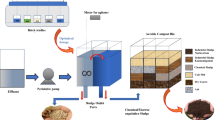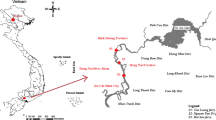Abstract
The huge quantity of effluent generated in coal washing processes contains large amount of suspended and dissolved solids, clay minerals, coal fines and other impurities associated with raw coal. The present system of recirculation of the effluent is found to be ineffective in removing colloidal fines, which is the major part of the impurities present in washery effluent. Hence, there is a need for the assessment of a better technique for an efficient removal of these impurities. This study deals with detailed characterisation of coal washery effluent and fine particles present in it. For efficient removal of impurities, the suitability of biocoag-flocculation process using Moringa oleifera seed biomass as a natural coagulant was examined. Various doses of M. oleifera ranging from 0.2 to 3 mL/L were used in order to determine the optimal conditions. The impact of the variations in pH of the effluent (2–10), contact time (5–30 min), settlement time (5–50 min), temperature (10–50 °C) and the effluent dilution (1:0–1:5) was also assessed to optimise the treatment process. Post treatment analysis was carried out for determination of the different parameters such as pH, conductivity, turbidity, solids and settling velocity. Excellent reduction in turbidity (97.42%) and suspended solids (97.78%) was observed at an optimum dose of M. oleifera seed coagulant of 0.8 mL/L with an optimum contact time of 15 and at 20 min of settling time. In comparison with very few past studies of M. oleifera in the treatment of coal washery effluent with high dose and inadequate removal, this study stands to be a major highlight with low dose and high removal of the impurities. M. oleifera coagulant is considered to be an environment-friendly material, therefore, its application is recommended for simple and efficient treatment of coal washery effluent.








Similar content being viewed by others
References
American Public Health Association. (2012). Standard methods for the examination of water and wastewater (22nd ed.). Washington, D.C.
Arora, V., Jha, U., Bandhopadhyay, P., & Kumar, S. (2006). An investigation of the relationships between raw coal characteristics and effluent quality of Kedla and Rajrappa washeries, Jharkhand, India. Journal of Environmental Management, 78, 392–404.
Arnold, B. J., Klima, M. J., Peter, J., & Ethell, B. (2007). Designing the coal preparation plant of the future. Colorado: Society of Mining, Metallurgy and Exploration Inc..
Ash, P. N., & Rao, R. R. S. (1972). Studies on coal preparation in India. Dhanbad: Central Fuel Research Institute.
American Society for Testing Materials. (2008). Standard practice for coagulation-flocculation jar test of water (D2035–08).
Atkins, P. W. (1998). Physical chemistry (6th ed.). Oxford: Oxford University Press.
Bhuptawat, H., Folkard, G. K., & Chaodhary, S. (2007). Innovative physico-chemical treatment of wastewater incorporating Moringa oleifera seed coagulant. Journal of Hazardous Material, 142, 477–482.
Bhatia, S., Othman, Z., & Ahmad, A. L. (2007). Coagulation flocculation process for POME treatment using Moringa oleifera seed extract: optimization studies. Chemical Engineering Journal, 133, 205–212.
Das, B., Prakash, S., Biswal, S. K., & Reddy, P. S. R. (2006). Settling characteristics of coal washery tailings using synthetic polyelectrolyte with fine magnetite. The Journal of the Southern African Institute of Mining and Metallurgy, 106, 707–712.
Duong, C., Choung, J., Xu, Z., & Szymanski, J. (2000). A novel process for recovering clean coal and water from coal tailings. Mineral Engineering, 13(2), 173–181.
Fan, C.-W.. (1984). Coal desulfurization and demineralization by chemical/physical treatments. Iowa State University, Retrospective Theses and Dissertations, Paper 8818.
Gassenschmidt, U., Klaus, D. J., Tauscher, B., & Niebergall, H. (1995). Isolation and characterization of a flocculating protein from Moringa oleifera Lam. Biochimica et Biophysicl Acta, 1243, 477–481.
Ghose, M. K. (1999). Sustainable supplies of water for coal washery in India. The Science of the Total Environment, 229, 217–225.
Ghose, M. K. (2001). Design of cost-refective coal washery effluent treatment plant for clean environment. Journal of Scientific & Industrial Research, 60, 40–47.
IS 2490-1. (1981). Tolerance limits for industrial effluent. New Delhi: Bureau of India Standards.
Mangale, S. M., Chonde, S. G., & Raut, P. D. (2012). Use of Moringa oleifera (drumstick) seed as natural absorbent and antimicrobial agent for groundwater treatment. Research Journal of Recent Sciences, 1(3), 31–40.
Manna, G. C., Chhabra, B. S., Rathore, G. S., Kumar, S., Hada, A. S. (2015). Energy Statistics, 22nd Issue, New Delhi: Ministry of Statistics and Programme Implementation, Govt. of India.
Menkiti, M. C., Nnaji, P. C., & Onukwuli, O. D. (2009). Coag-flocculation kinetics and functional parameters response of periwinkle shell coagulant (PSC) to pH variation in organic rich coal washery effluent medium. Nature and Science, 7, 1–18.
Menkiti, M. C., Nnaji, P. C., Nwoye, O. D., & Onukwuli, O. D. (2010). Coag-flocculation kinetics and functional parameters response of Mucuna seed coagulant to pH variation in organic rich coal washery effluent medium. Journal of Minerals and Materials Characterization and Engineering, 2, 89–103.
Menkiti, M. C., Nwoye, C. I., Onyechi, C. A., & Onukwuli, O. D. (2011). Factorial optimization and kinetics of coal washery effluent coag-flocculation by Moringa oleifera seed biomass. Advances in Chemical Engineering & Science, 1, 125–132.
Menkiti, M. C., & Onukwuli, O. D. (2011). Coag-flocculation studies of Afzelia bella coagulant (ABC) in coal effluent using single and simulated multi angled nephelometry. Journal of Minerals and Materials Characterization and Engineering, 10(3), 279–298.
Miretzky, P., Saralegui, A., & Fernandez Cirelli, A. (2004). Aquatic macrophytes potential for the simultaneous removal of heavy metals (Buenos Aires, Argentina). Chemosphere, 57, 997–1005.
Moosavirad, S. M., Shankara, M., & Janardhana, M. R. (2010). Assessment of the relationship between raw coal and effluent quality of Zarand washery plant, Kerman province, south east of Iran. Pollution Research, 29(4), 1–4.
Ndabigengesere, A., Narasiah, K. S., & Talbot, B. G. (1995). Active agents and mechanisms of coagulation of turbid waters using Moringa oleifera. Water Research, 29(2), 703–710.
Nnaji, P. C., Okolo, B. I., & Menkiti, M. C. (2014). Nephelometric performance evaluation of oxidized starch in the treatment of coal washery effluent. Natural Resources, 5, 79–89.
Nougbode, Y. A. E. I., Sessou, P., Alassane, A., Youssao, A. K. A., Agbangnan, C. P., Mama, D., & Sohounhloue, K. C. D. (2016). Evaluation of Aloe vera leaf gel as a natural flocculant: phytochemical screening and turbidity removal trials of water by coagulation flocculation. Research Journal of Recent Sciences, 5(1), 9–15.
Rao, S. R. (1982). Surface chemistry of froth flotation (2nd ed.). New York: Plenum Publishers.
Sabah, E., Yüzer, H., & Celik, M. S. (2004). Characterization and dewatering of fine coal tailings by dual flocculent system. International Journal of Mineral Processing, 74, 303–315.
Sabah, E., & Cengiz, I. (2004). An evaluation procedure for flocculation of coal preparation plant tailings. Water Research, 38, 1542–1549.
Sabah, E., & Erkan, Z. E. (2006). Interaction mechanism of flocculant with coal waste slurry. Fuel, 85, 350–359.
Sarioglu, M., Cebeci, Y., & Beyazit, N. (2002). Investigation of the effects of some operating parameters using anionic and cationic flocculants for removing solid material in the lignite. Asian Journal of Chemistry, 14(1), 388–394.
Saritha, V., Srinivas, N., Srikanth Vuppala, N. V. (2015). Analysis and optimization of coagulation and flocculation process. Applied Water Science. doi:10.1007/s13201–014-0262-y.
Srinivasan, R. (2013). Natural polysaccharides as treatment agents for wastewater. Green materials for sustainable water remediation and treatment. London: The Royal Society of Chemistry.
Swaine, D. J. (1990). Trace elements in coal (chapter 9). London: Butterworth.
Thawari, D. B., & Verma, S. (2015a). Coal washery wastewater treatment using natural coagulants and chemical precipitation. International Journal of Science and Research, 4(6), 1877–1881.
Thawari, D. B., & Verma, S. (2015b). Clarification of colliery effluent using natural and chemical coagulants. International Journal of Advance Foundation and Research in Science & Engineering, 1, 124–132.
Tiwari, R. K., & Dhar, B. B. (1994). Environmental pollution from coal mining activities in Damodar river basin, India. Mine Water & the Environment, 13, 1–10.
Xiao, F., Huang, J. H., Zhang, B., & Chong-wei, C. (2009). Effects of low temperature on coagulation kinetics and floc surface morphology using alum. Desalination, 237, 201–213.
Acknowledgements
The authors acknowledge the support provided by the Department of Environmental Science and Engineering, Indian Institute of Technology (Indian School of Mines), Dhanbad, for carrying out this research work.
Author information
Authors and Affiliations
Corresponding author
Rights and permissions
About this article
Cite this article
Kapse, G., Patoliya, P. & Samadder, S.R. Characterisation of coal washery effluent and optimisation of coagulation behaviour of Moringa oleifera seed as a coagulant. Environ Monit Assess 189, 133 (2017). https://doi.org/10.1007/s10661-017-5844-3
Received:
Accepted:
Published:
DOI: https://doi.org/10.1007/s10661-017-5844-3




